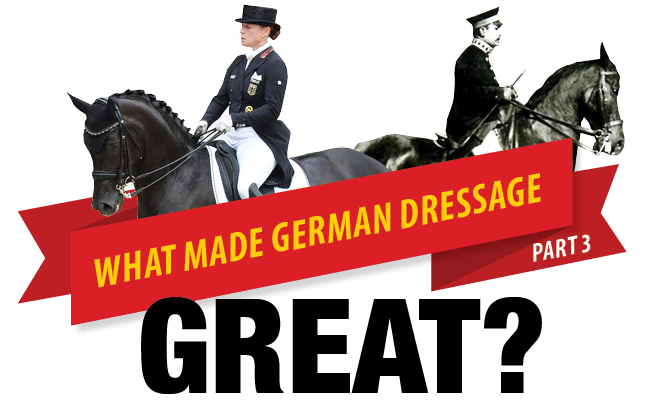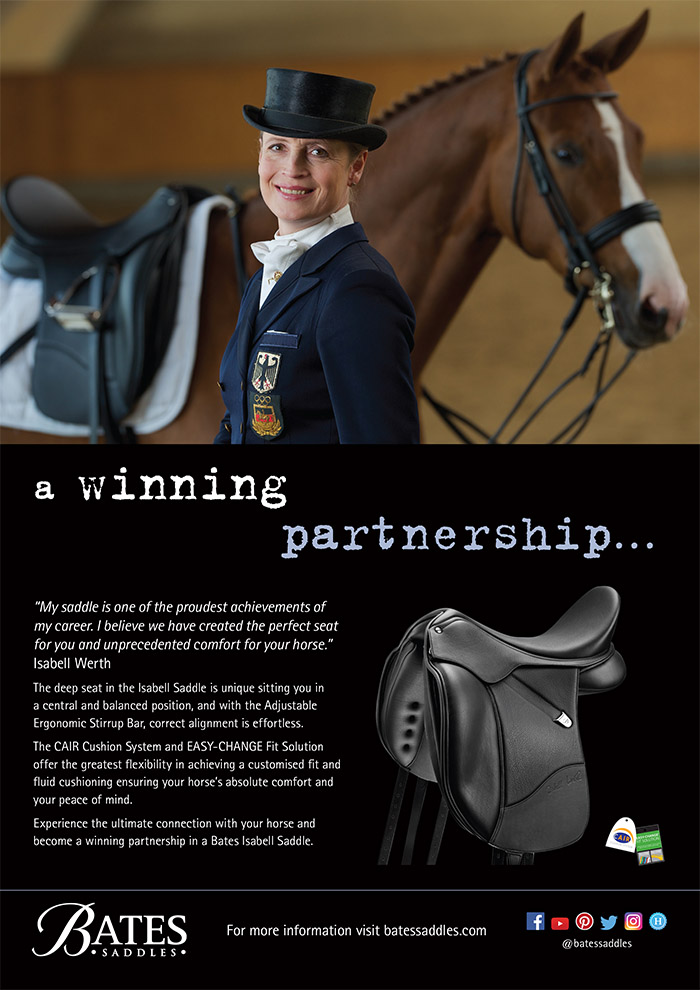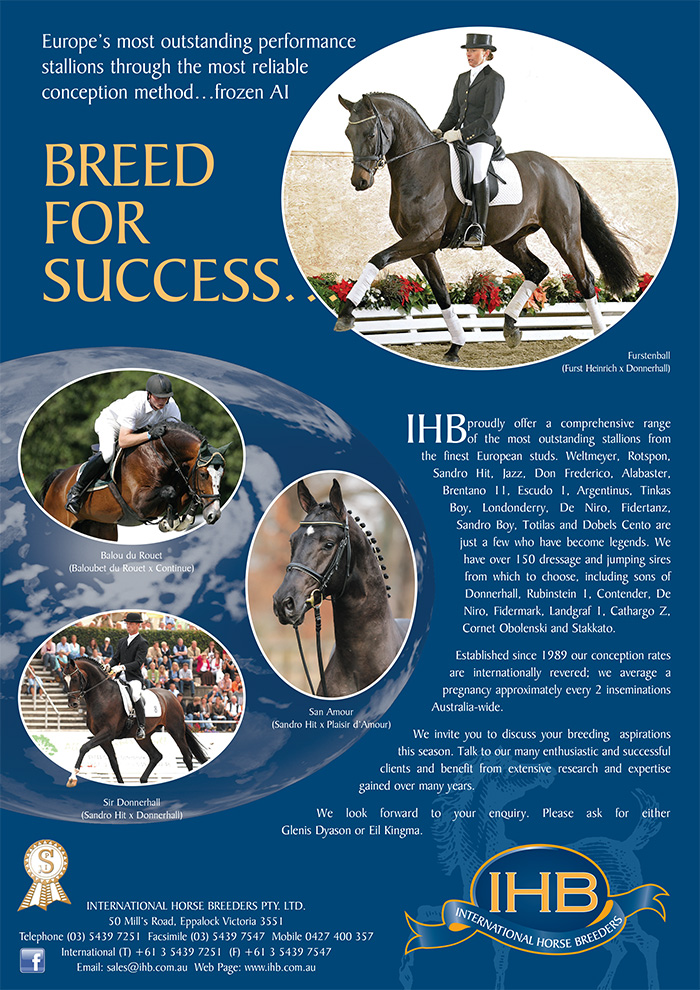In this our third (if first you would like to read part one click, or part two, click) part of this series by Christopher Hector, we meet Paul Schockemöhle, who with his stallion, Sandro Hit, has changed the face of dressage breeding. We also listen to the wisdom for Dr Gerd Lehmann – and then look at the influential dressage stallions…
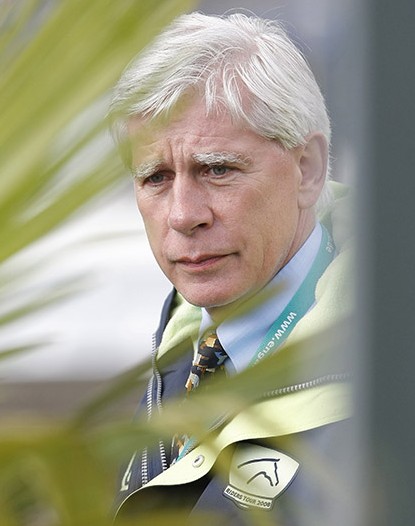
Mr Mover and Shaker: Paul Schockemöhle
When it was discovered that money was to be made in dressage horses, it soon attracted the attention of one of the movers and shakers of the equestrian scene, Paul Schockemöhle. It seems that some of the key players in the emergence of German dressage, were the originals, the ones that pushed the envelope, who occasionally caused waves, Schockemöhle fits nicely into the tradition of Maas J Hell, Vorwerk and Köhler.
Born in 1945 Paul is one of three brothers, two of whom, Alwin and Paul became international showjumping riders, one, Werner, an expert on Warmblood breeding. Paul was three times European champion with Deister, the horse that still features on his brochures and publicity material – for he has been instrumental in turning jumping into a multi-million euro business.
The PSI empire started in 1974 when the brothers Alwin, Paul and Werner decided to purchase stallions to stand at their parents’ farm in Mühlen. Breeding has always been a tradition with the Schockemöhle family, father Alois and grandfather Alwin had previously owned stallions.
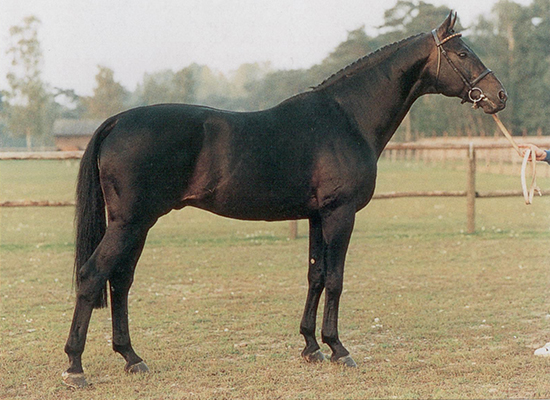
Sandro – the Holsteiner begins a dressage line…
At first the Schockemöhle line up didn’t feature dressage lines, but that changed when Paul purchased Sandro (Sacramento Song / Wahnfried) in 1985. At first Sandro provided great jumpers, the combination with Gepard (Gotthard / Florentiner II) mares produced Sao Paulo, Silvio I and II and Sandro Song, the sire of Sandro Hit (Ramino), and Sandro Hit was to usher in a whole new era of dressage breeding at Mühlen.
Although the dressage stallions now attract many more mares than the showjumping stallions, Paul Schockemöhle’s first love remains jumping. He founded the Springpferdezuchtverband Oldenburg-International (OS) and has been its chairman ever since.
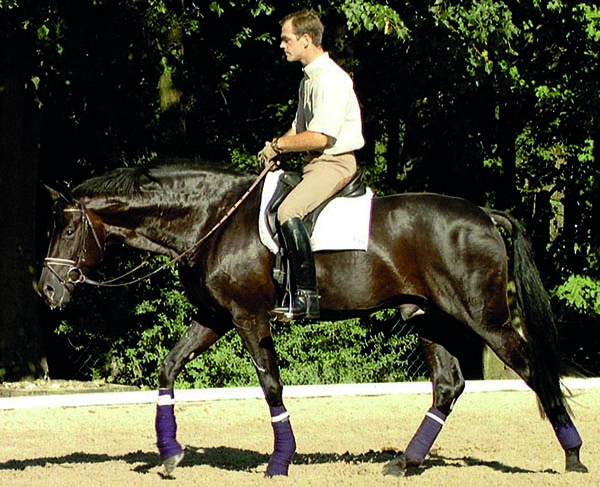
Ulf and Sandro Hit the year of their victory at the Bundeschampionat
Ulf Möller, a long time PSI employee before he left to join Andreas Helgstrand, described the process behind the switch from jumping to dressage that started in 1999 when he won the six-year-old Championship with the black stallion at the Bundeschampionate.
Ulf rode Sandro Hit throughout his career:
“Sandro Hit was the stallion that gave Paul Schockemöhle the idea to run the breeding stud seriously. Before he had owned Don Schufro, but then he got a good offer, and sold him. That was his idea – he had good stallions, but if he had a good offer – whoosh – they were gone. Sandro Hit was the first stallion where he got a really really big offer and said, no, I keep him. Then it worked, and gave him the idea that it is worth keeping the good stallions for a while and then to decide what to do – because it is a business, it is not a state stud supported by the government. At the moment I think we can offer every breeder in the world, a stallion for his special mare, because we have such a variety of stallions.”
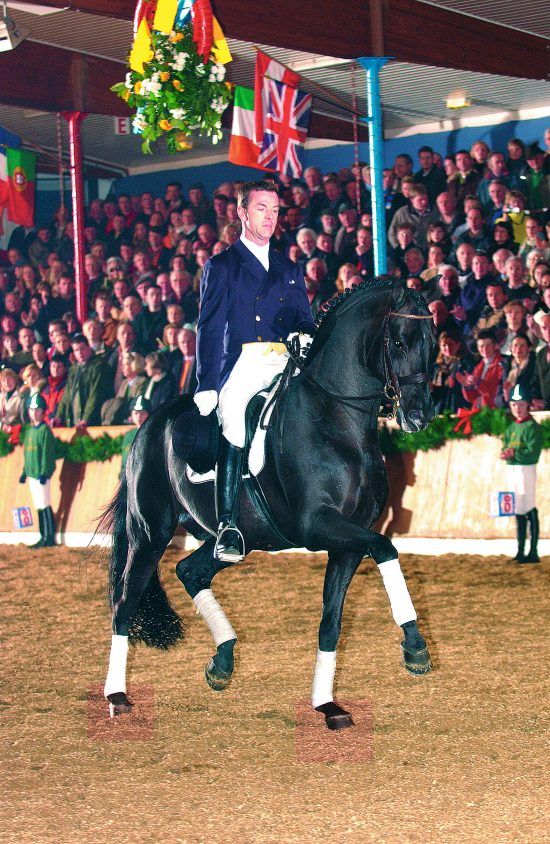
Sandro Hit – now PSI was a stallion station
Once it looked as if while you could breed radical crosses in jumping with success, French to Holstein, for instance, but the best dressage horses came from bloodlines that were concentrated dressage producers. As usual, Paul Schockemöhle keeps his own counsel:
“You can breed wider with dressage horses,” he told me. “Once upon a time people thought you could only breed dressage horses with Donnerhall, Weltmeyer and Rubinstein. But then you find jumping stallions like Sandro establishing a dressage line through his grandson Sandro Hit, there luckily the bloodlines are not so close together – they don’t have to be so close together.”
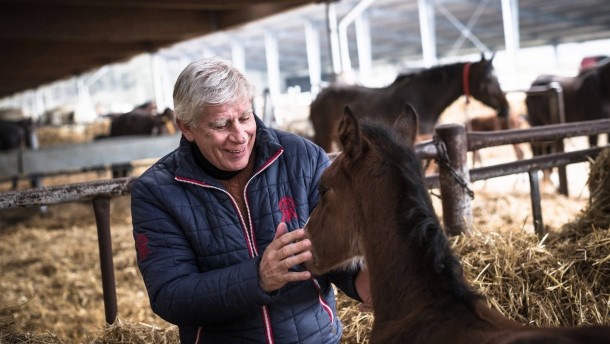
What made you decide that Sandro Hit would make a dressage horse – there is not a lot of dressage on his pedigree?
“He was moving very well as a foal. As a two-year-old we knew he was a very good type, he was moving well, and we brought him to the stallion grading at Oldenburg.”
They didn’t like him though?
“But he passed, and then because he had a funny bloodline for a dressage horse, he had to prove himself, and he did.”
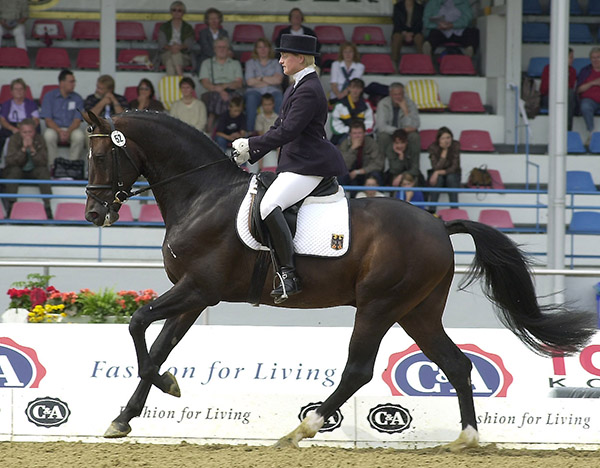
Diamond Hit, another product of Sandro Hit’s dam
He then went on to breed very good foals, were you worried that he was a result rather than a cause?
“His mother breeds very good horses. She is a fantastic mover, from her I have a number of top foals. Diamond Hit who was reserve champion at the World Young Horse Championships is also from that mare, and Diamond Hit is probably better than Sandro Hit.”
You are primarily a jumping breeder but you are breeding so many dressage horses?
“That is primarily for economic reasons, a three-year-old dressage horse that has good movement, you sell even better than a five-year-old jumper.”
Sandro Hit established the pattern of the ‘hot’ PSI stallions breeding 600 to 800 mares in a season, leading to the suggestion that PSI has become the de-facto German National Stud.
next we talk to Dr Gerd Lehmann
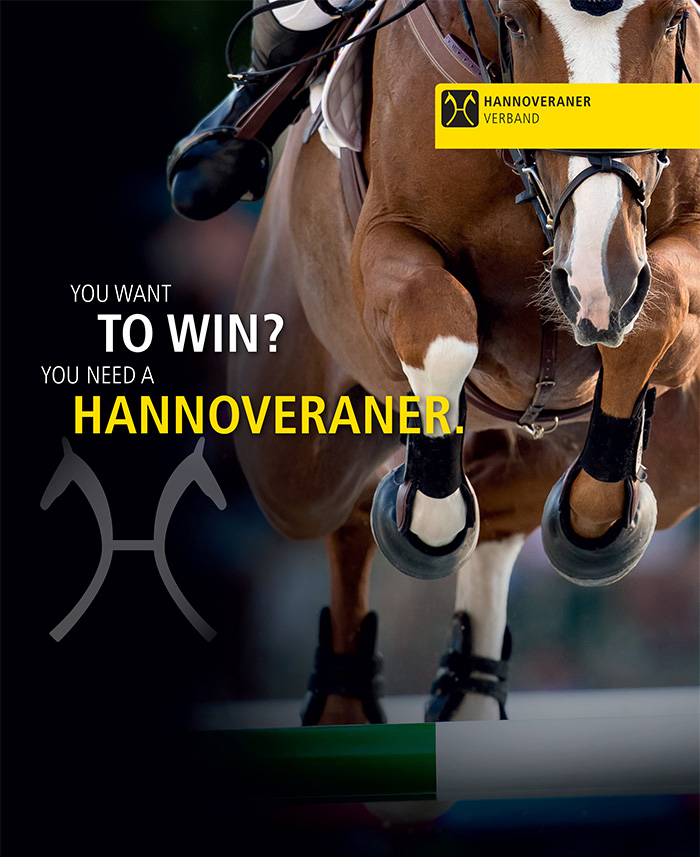
Dressage breeding and specialisation:
As the swing to dressage breeding took off in the 90’s, there were some, like Dr Gerd Lehmann – Director of the Westfalien State Stud from 1966 to 1995 – who sounded a warning. In an interview I conducted back in 2001, Dr Lehmann warned against too much dressage specialisation:
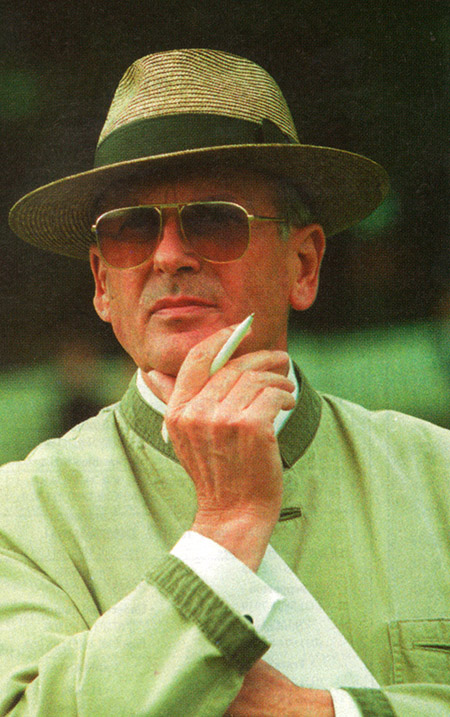
“Of course breeders talk about dressage lines and jumping blood, but you shouldn’t do it. Look at Pilot, with a lot of dressage blood, like Graphit, yet Pilot was one of the best ever showjumping sires and all his offspring had rideability. From the great jumping line of Precipitation, through Furioso II we have Florestan who produces horses of high rideability for dressage and showjumping. It is most important that any stallion should be able to jump small jumps. The freejumping is a qualification for the stallion licensing, and the stallions that do not show any jumping ability should not be licensed.”
Is it ever likely to happen that this process will be reversed, and that the Hannoverian Verband will look to licensing stallions with both abilities?
“I would ask the licensing commission not to license stallions that cannot jump, but if there was a really really spectacular stallion who could move, but not jump, then you can put him in a big population. You can do that once or twice a year, with a really big population and a really spectacular stallion. We present the stallions on hard ground at the licensing, and if the young stallion shows high elasticity and a really nice and flowing movement, then he can jump.”
Back then, some considered Dr Lehmann hopelessly out-of-date as they rushed to pile dressage blood on dressage blood. Fifteen years later, when the FN has been forced to create a separate category for sires of young horse competitors, ie. the ones that don’t have the motor or the mind to go on to the big sport – and when many of the top Grand Prix stallions are showing the benefit of the right sort of jumping blood in their pedigrees, perhaps it was Lehmann who was in touch…
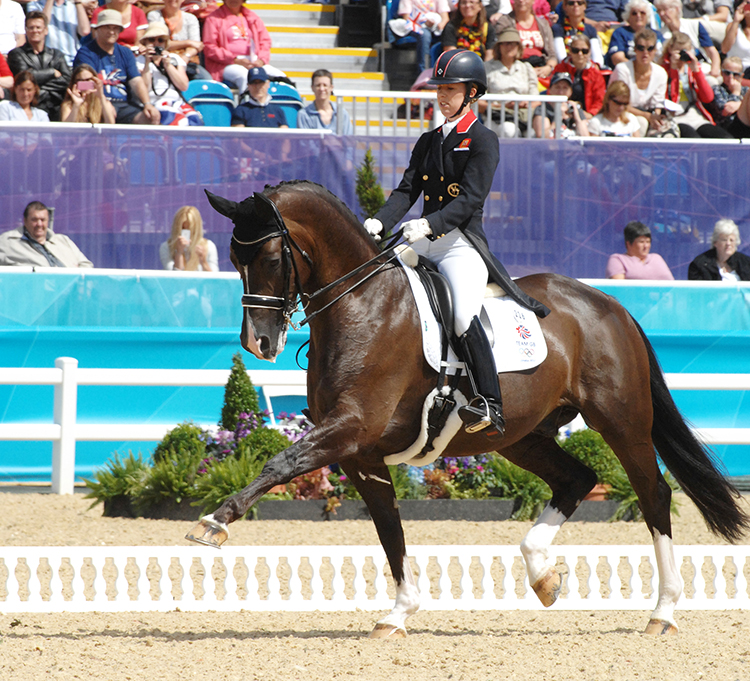
Valegro, dressage great, by a grand-son of Ferro who was initially bred – and trained – as a showjumper, out of a mare by Gershwin, that’s Voltaire and Nimmerdor, two of the greats of Dutch jumping breeding.
story continues below the advertisement
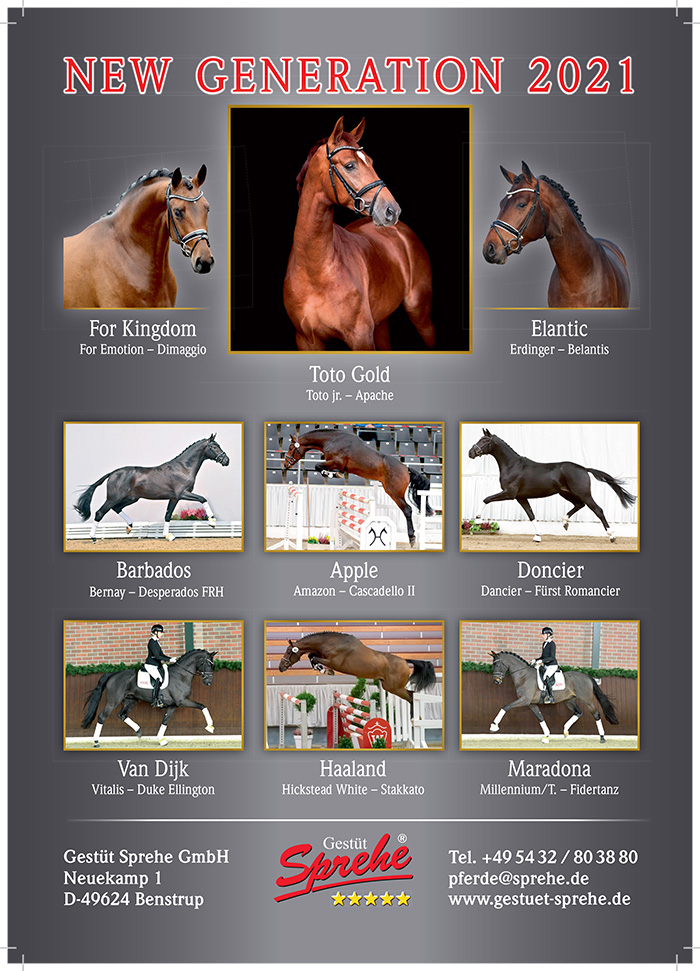
The Dressage Stallions
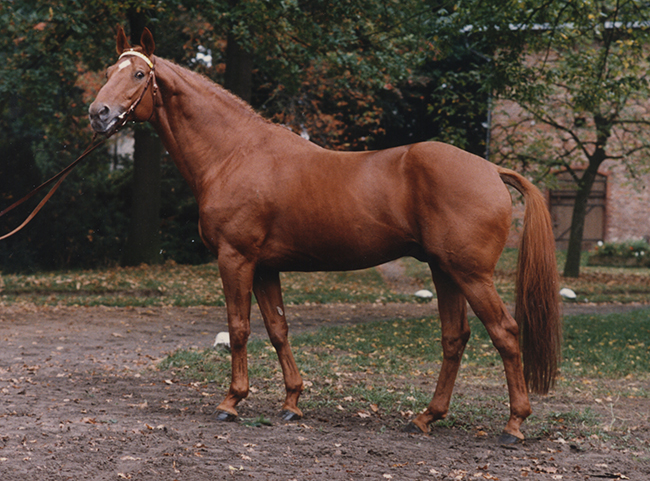
Bolero, one of the first dressage specialists…
The first of the dressage specialist stallions was the short-lived, Bolero (1975 – 1987). Bolero was by the elegant English Thoroughbred, Black Sky, his dam, Baroness was by another English Thoroughbred, Bleep. He was stationed Landesbrück where he clicked with the daughters of Grande and Duellant.
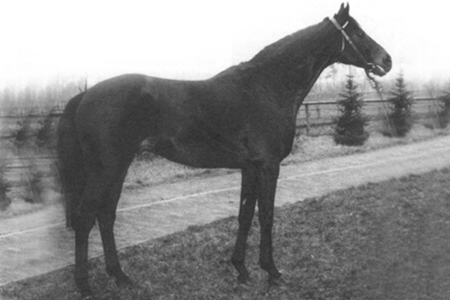
Black Sky – the Thoroughbred influence
In his nine seasons at stud, Bolero sired 47 licensed stallions, many of whom disappeared without trace. His most influential stallion sons have been Brentano II (Grande) and Bismark. Bismark, out of a Duellant mare, is the sire of the 2017 number one dressage sire on the German FN’s rankings for sires of open competitors – Breitling (Maat I).
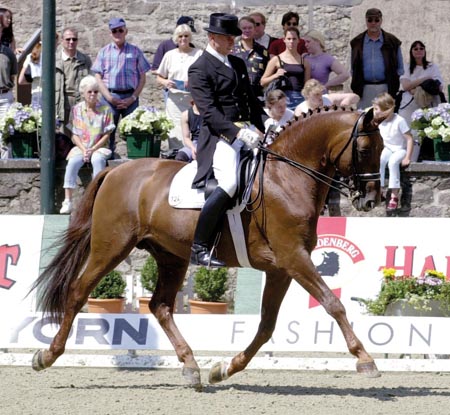
Breitling – number one dressage sire in 2018
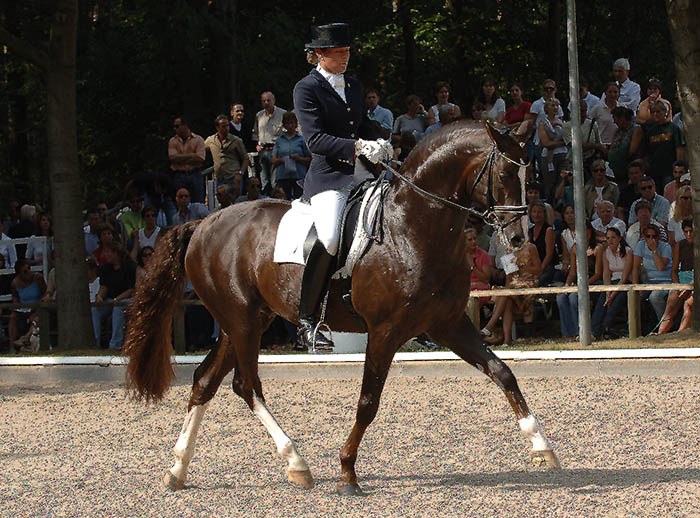
Belissimo, Bundeschampion
Another son, Beltain (Grande) was the sire of the Champion Six-year-old horse at the 2005 Bundeschampionate, Belissimo who has gone on to be a good dressage sire himself.
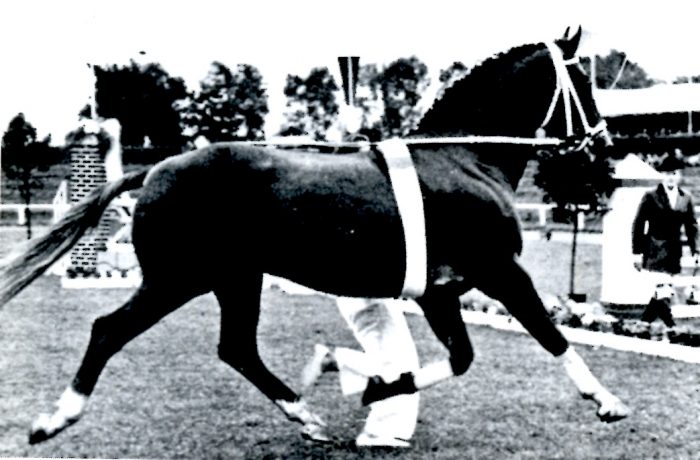
Wöhler – first of the Ws
Then came the W’s, the descendants of Woermann. Woermann was by Wöhler out of a mare by the Thoroughbred Marabou xx. Born in 1971, he died in 1988 but not before he established something of a dressage dynasty through his sons, Wenzel (Matador) and three full brothers, out of a Sender mare – World Cup I, World Cup II and World Cup III. Sender was by the Semper Idem son, Senator out of an Abendsport (grandson of Alderman, Ludwig’s A line lives again) mare.
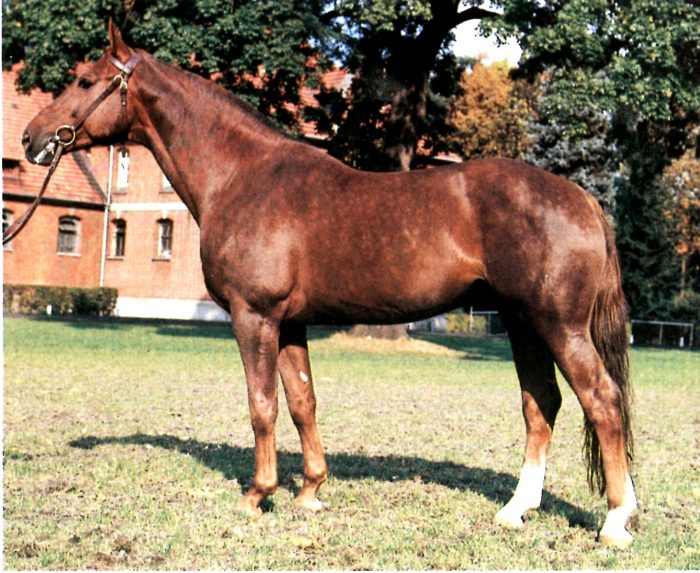
Woermann, establishes a dressage dynasty
World Cup I sired Weltmeyer and suddenly the dressage craze was in full swing. Weltmeyer (1984 – 2011) was only 17.59% Thoroughbred, but this was compensated by the Trakehner blood that ran through his veins. World Cup’s dam was by Sender, a grandson of the Trakehner, Semper Idem, and Weltmeyer’s dam was by Absatz, the best son of the influential Trakehner, Abglanz. She also carried the blood of another of the post-War refiners – Adlerschild xx.
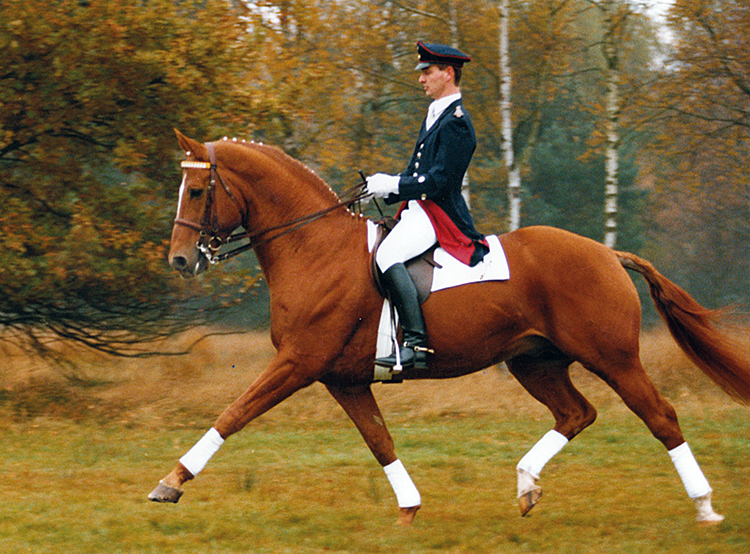
Weltmeyer – for a while he was THE dressage stallion in Hanover
Weltmeyer was the champion of his licensing, and went on to win the German young horse championship, the famed Bundeschampionate, and to win his stallion performance test. EVERYONE wanted to breed a Weltmeyer. State stud director, Dr Bade took the then unprecedented step of not sending Weltmeyer out to a stallion station, but keeping him at the central breeding station in Celle where he was bred to 200 main studbook and State Premium mares from all over the Hanoverian breeding district. This was a ‘kick start’, the like of which no other first season stallion had received, and there are still those who question Weltmeyer’s success, claiming that it comes in no small part from the superior mares he covered.
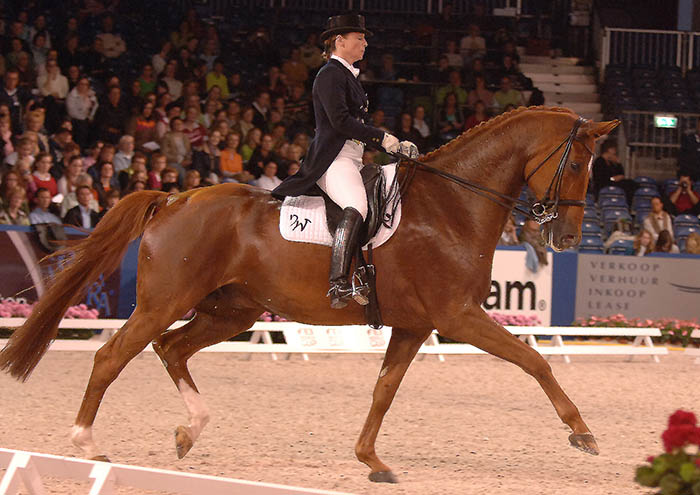
Warum Nicht with Isabel, never a super-star
For a while Weltmeyer bred one winning son after another, licensing champions, performance test champions, Budeschampions, but finally the truth emerged, he was not a great sire of Grand Prix competition horses. His best was the oddly conformed Warum nicht (out of a mare by another of the early dressage sires, Wenzel) but even with the great Isabell Werth in the saddle, or is that, because he had Isabell in the saddle, he was competent but never a super-star.
next talk about the very successful D line
Slowly the painful reality dawned in Hanover, that the real dressage stallion star was, despite his Hanoverian breeding, across the border, in the land of the great rivals, Oldenburg, and that was Donnerhall.
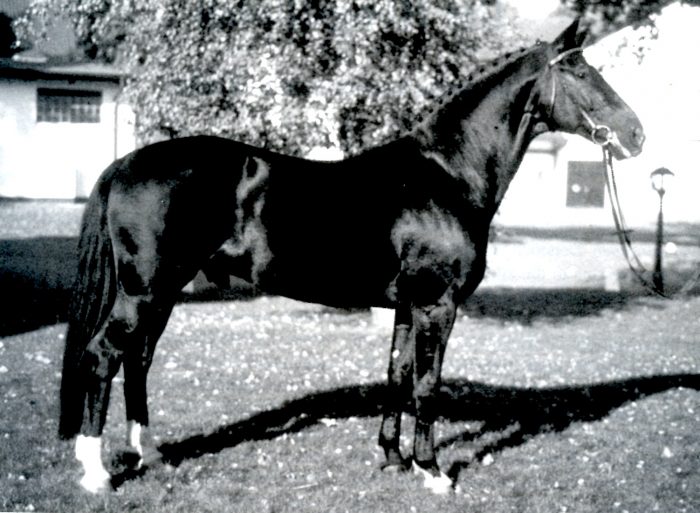
Donnerwetter – sire of Donnerhall
Donnerhall’s sire, Donnerwetter was a great, great, grandson of Detectiv, from Ludwig’s famous Devil’s Own xx ‘D’ line. Donnerhall’s dam, Ninette carries the blood of the old Oldenburg coach horses, with an infusion from the first of the Selle Français stallions to shape the modern Oldenburg dressage horse, Condor (Foudroyant II / Bambocheur). Recently I asked Jan Tönjes, editor of St Georg magazine, and an expert on Warmblood breeding, why Donnerhall had become such a dominant force, and he suggested to me that old coach blood may play its rôle:
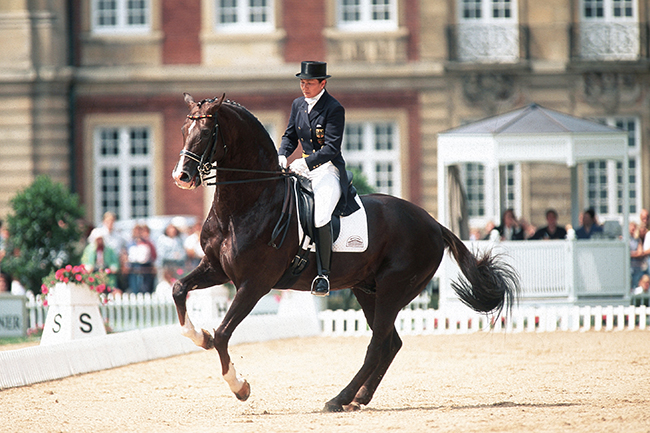
Donnerhall – the greatest dressage sire of them all
“It has in my opinion, two reasons. First of all, and it is in the breeding, he is a very solid type of horse, with this third dam still belonging to the old Oldenburg Coach type. When he was certified, even then, people thought he was not the modern type.”
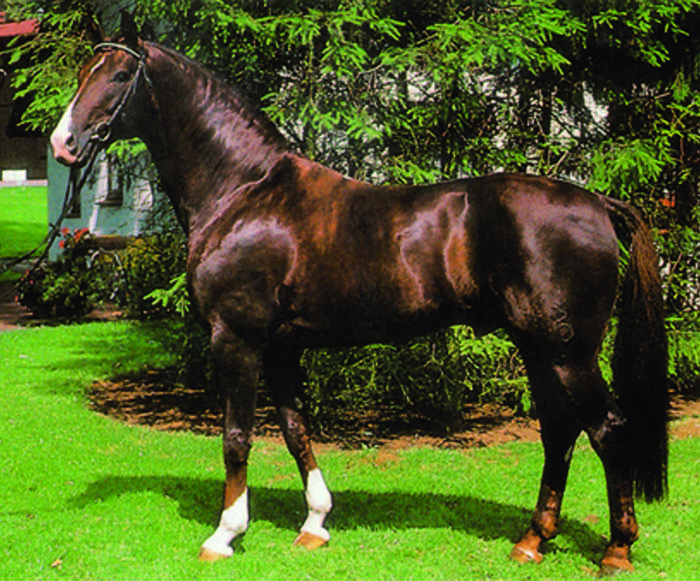
“He had a bit of a plain head, but always loads of expression in his eye, his croup was not the ideal, but these coach horses were two things: they were eager to work every day, they had a super attitude, which always helps, rideability is always something you would associate with ‘D’ rather than ‘W’. Plus, they had to stay sound conformation-wise. I can’t say that Donnerhalls are the soundest horses in the world, but look at some of the other lines – you buy them and then you keep them doing the job, but not too much.”

“But with the Donnerhalls you can ride them, they are tough guys, and again, maybe you don’t need to train them as much as the others, so they don’t have the mileage which helps their soundness again. These are the two things that I think make the Donnerhall line the complete package.”
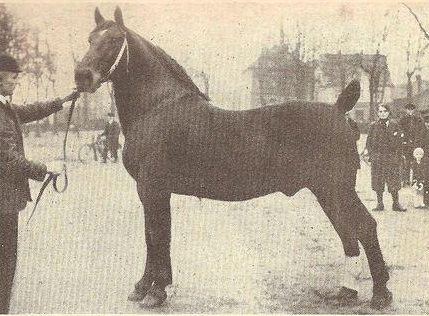
Gruson born in 1917. Donnerhall has six crosses of the stallion…
And Donnerhall, unlike Weltmeyer, was not just a dressage sire, he was one of the world’s best dressage competitors with Karin Rehbein in the saddle, and he went on to not only sire competitors but also successful sires. Indeed if we look at the 2017 German FN breeding values for sires of open competition horses, we find that Donnerhall himself is in equal 6th while his sons, Don Schufro and Damon Hill are 2nd and 4th. The 2017 WBFSH dressage rankings are headed by his son, De Niro for the third year in a row, while Donnerhall himself, was second to his great rival, the Dutchman, Jazz for three years in a row, from 2008 to 2010.
Wait there is more to come in this eight part series, but in the meantime, check out our equestrian library – it’s FREE
http://www.horsemagazine.com/thm/article/dressage/

